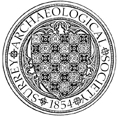The first of two phases of excavation by N Randall of SCAU following evaluation revealed part of a previously unknown, early medieval, Christian burial ground across much of the higher ground on the east of the site. The graveyard, presumably originally part of the nearby St Peter and Paul’s church, appears to have gone out of use in the medieval period. The lack of later intrusive burials makes it a rare and important discovery.
